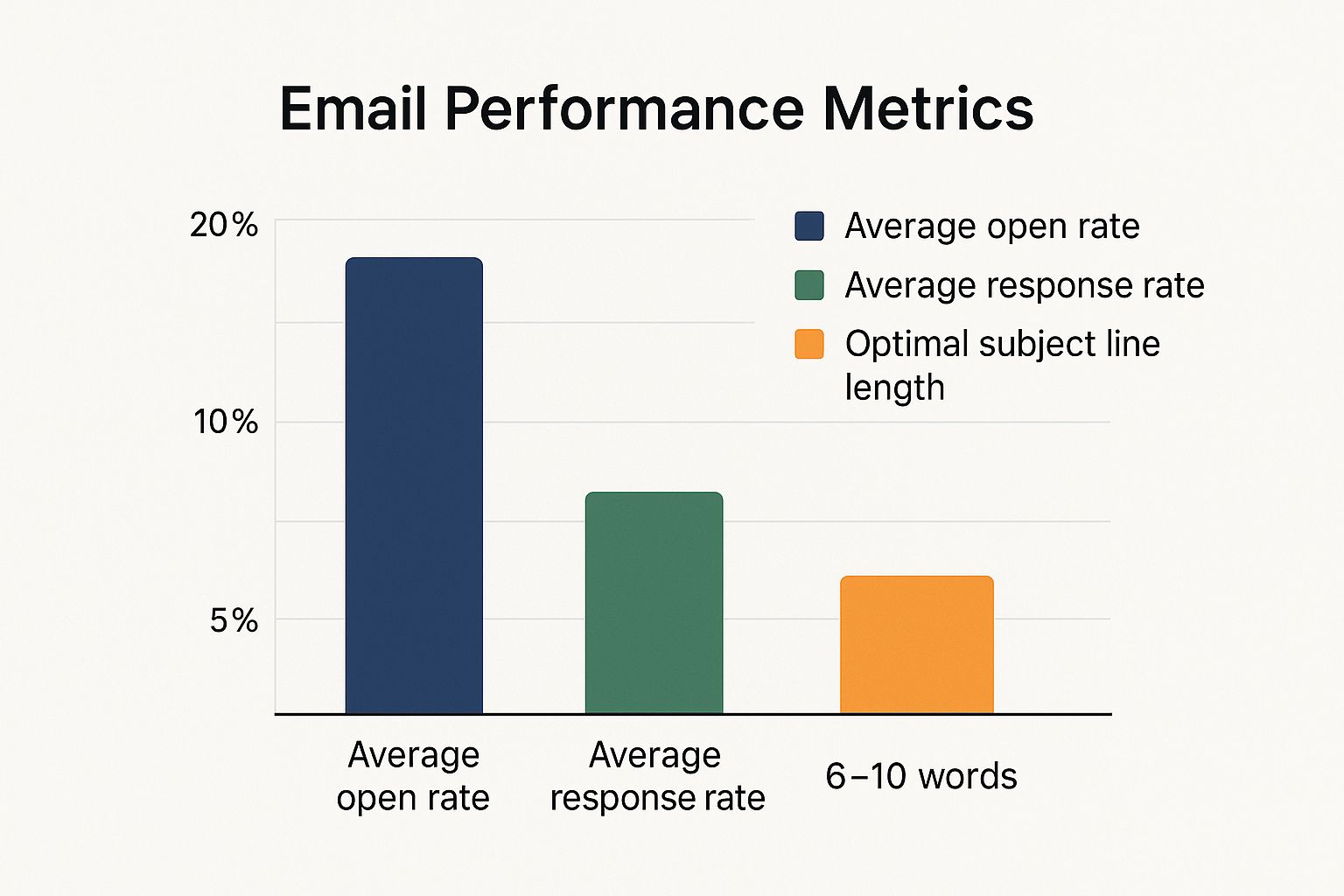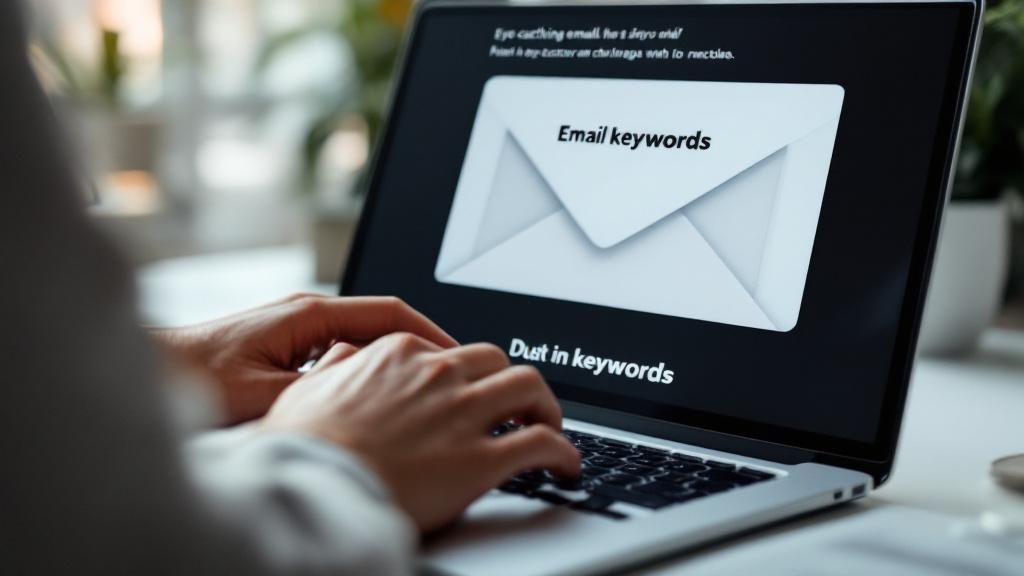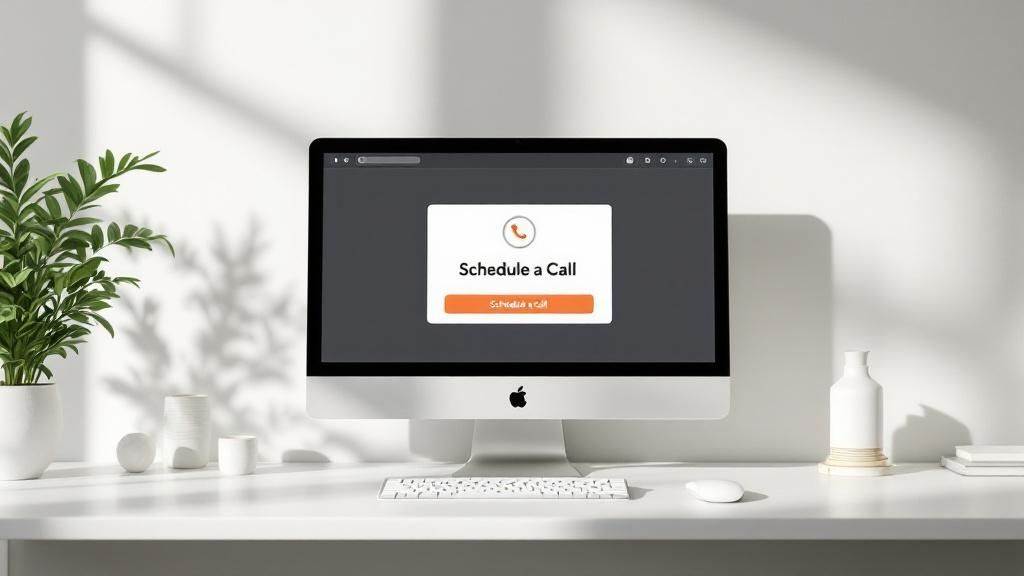If you want to write cold emails that actually get replies, you have to stop thinking about blasting messages and start thinking about starting conversations. The best cold emails I’ve ever seen—the ones that truly work—are short, incredibly personal, and laser-focused on giving the other person value, not just pitching them something.
Why Most Cold Emails Fail (And Yours Won’t)
Are you staring at a painfully low reply rate? Don't worry, you're not the only one. Most cold emails land in the inbox with a thud and get completely ignored because they feel generic, pushy, and just plain uninspired. Let's be honest, the inbox is a battlefield for attention. To win, you need a real strategy, one built on authentic connection, not just blind automation.
The biggest mistake I see people make is forgetting there’s a human on the other end of that email. Too many salespeople and marketers fall into the trap of treating outreach like a pure numbers game. They spray thousands of templated messages, just hoping something sticks. This doesn't just annoy prospects; it actively hurts your brand and your email deliverability. Before you know it, your emails are routed straight to spam, and your domain gets blacklisted, making any future outreach next to impossible.
The Sobering Reality of Cold Email Performance
The data doesn’t lie, and it paints a pretty clear picture of just how tough it is out there. Engagement is down across the board, making it harder than ever to cut through the noise.
In 2025, the average open rate for cold emails dipped to just 27.7%, a noticeable drop from previous years. But here’s the stat that really matters: the average reply rate is a tiny 5.1%. That means for every 100 emails you send, you can expect about 95 of them to get no response at all.
This image really drives home how narrow the margins are.

Getting someone to open your email is one thing. Getting them to actually hit "reply" is a whole different mountain to climb.
Shifting from Failure to Connection
So, how do you break into that successful 5%? It all comes down to a fundamental shift in your approach.
The goal of a cold email isn't to make an instant sale. It's to start building a relationship—to turn a complete stranger into a potential business partner by showing you've done your homework and have a genuine interest in them.
This means you have to ditch the "one-size-fits-all" template for good. Your new mission is to write messages that feel like they were written by one person, specifically for another person.
To pull this off, you need to nail three core principles:
- Authentic Personalization: This goes way beyond just dropping in a
{{first_name}}. Mention a recent article they published, a project their company just launched, or even a thoughtful comment they left on LinkedIn. Show them you actually see them. - A Value-First Mindset: Instead of immediately asking for 15 minutes of their time, offer something valuable right away. It could be a unique insight, a link to a helpful resource, or a quick thought on a problem you've noticed they might be facing.
- Precise Targeting: Make absolutely sure you’re emailing the right person at the right company. A perfectly written email sent to the wrong contact is still a complete waste of time.
To really understand what works, it helps to see the difference between a common mistake and an effective strategy laid out side-by-side.
The Anatomy of a High-Performing Cold Email
| Component | Common Mistake | Effective Strategy |
|---|---|---|
| Opener | "Hi, my name is…" or "I hope this email finds you well." | "Saw your post on LinkedIn about scaling your dev team…" |
| The "Why" | "I'm reaching out because we sell…" | "I noticed your company is hiring for X, which made me think about Y." |
| Value Prop | Listing all your features and benefits. | Offering a specific, relevant insight or a helpful resource. |
| Call-to-Action | "Are you free for a 15-min call next week?" | "Mind if I send over a couple of ideas on this?" |
| Tone | Formal, corporate, and robotic. | Conversational, respectful, and human. |
By mastering these elements, which are covered in depth in these cold email best practices, your outreach goes from being an annoying interruption to a welcome conversation. And when you realize the financial upside, like learning new strategies for generating sales without traditional sales calls, the importance of getting this right becomes crystal clear.
This is how you write cold emails that people actually want to open, read, and reply to.
Getting Your Research and Targeting Right
The secret to cold emails that actually get a reply? It has nothing to do with fancy templates. The real work happens before you even think about writing.
Exceptional outreach is all about the research you put in upfront. This is what separates a genuine conversation starter from just another email clogging up someone's inbox.
Your first job is to get crystal clear on who you're really trying to reach. Go beyond basic demographics and sketch out a detailed ideal customer profile (ICP). Think about their specific role, the industry they're in, their company size, and—most importantly—the unique challenges someone in their shoes is probably wrestling with. This focus stops you from wasting time on prospects who were never going to be a good fit anyway.
Digging for Personalization Gold
Once your ICP is locked in, it's time to find that "why you, why now" angle. This means you have to go deeper than a quick scan of their LinkedIn profile. You're hunting for specific, recent, and relevant details that give you a legitimate reason to connect.
Think of it as looking for key triggers. I usually scan for things like:
- Company News: Did they just land a new round of funding? Announce a big product launch? Get a nice feature in an industry publication?
- Hiring Trends: Are they posting jobs for roles your product could support? If a company is suddenly hiring a "Head of SEO," you can bet they have a new focus you can speak to.
- Individual Activity: Did your prospect just publish an article, speak at a conference, or even just post a thought-provoking question on social media?
- Tech Stack: Do they use software that pairs perfectly with what you offer?
Tools like LinkedIn Sales Navigator are a massive help here. You can set up alerts to get pinged whenever these kinds of updates happen.
Using filters to pinpoint prospects who have recently switched jobs or posted about specific topics gives you a perfectly timed excuse to slide into their inbox.
Making Sure Your Message Actually Arrives
All that brilliant research is completely wasted if your email lands in the spam folder. Don't skip the technical setup. This means properly warming up your email domain to build a good sender reputation with services like Google and Microsoft.
An often-overlooked part of deliverability is list hygiene. Sending emails to bad addresses torpedoes your sender score and can get you flagged.
On average, you can expect a bounce rate around 7.5% on cold email campaigns. That includes temporary "soft" bounces and permanent "hard" bounces. Those hard bounces from invalid addresses are what really hurt you. Cleaning your email list before you hit send isn't optional—it's essential for staying in the inbox.
Going beyond just finding contacts, implementing a sales qualification framework helps you confirm you're only chasing prospects who are a genuinely good fit and more likely to buy. This groundwork makes your personalization feel authentic and sets you up for success right from the start.
Crafting Subject Lines and Openers That Get Clicks

Think of your subject line as the gatekeeper to your entire message. It’s often the single biggest reason your well-researched email gets opened or just trashed. The goal isn’t to write clickbait; it's to spark genuine curiosity.
You have to forget the generic, lazy lines like "Quick Question" or "Checking In." Prospects see right through those low-effort tactics these days. If you want to earn that click, your subject line needs to scream relevance and value from the second it hits their inbox. It has to show you've done your homework.
Subject Lines That Actually Work
The best subject lines are specific, personal, and often a little intriguing. They give a sneak peek of the valuable, relevant content waiting inside. I’ve seen a few approaches that consistently get results when you’re writing cold emails.
Here’s what I mean:
- Reference a recent event: "Your recent feature in TechCrunch"
- Mention a mutual connection: "John Smith suggested I reach out"
- Pose an insightful question: "Idea for scaling your sales team?"
- Highlight a specific observation: "Noticed your post on LinkedIn about AI"
Why do these work? Because they aren't about you or your company. They're about the prospect—their work, their company, their world. That small shift in focus makes a huge difference. If you want to go deeper, there are plenty of great email subject lines for sales you can adapt for your own campaigns.
A great subject line makes a promise that the opening line keeps. It creates a seamless transition from the inbox preview to the body of your email, assuring the reader that opening your message wasn't a mistake.
This link between the subject and the opener is absolutely critical for keeping their attention.
Hook Them With Your Opening Line
Once they click open, you've got maybe three seconds to convince them to keep reading. Your first sentence or two—your hook—has to prove this email was written just for them. This is where all that research you did pays off.
Before (Generic):
"My name is Alex from Company XYZ, and we provide solutions for businesses like yours."
This is an instant turn-off. It’s all about the sender and immediately signals a generic sales pitch, giving them every reason to tune out and hit delete.
After (Personalized):
"I saw your presentation on sustainable logistics at the Supply Chain Summit last month—your points on last-mile efficiency were fantastic."
See the difference? This opener is specific, offers real praise, and creates a clear, non-salesy reason for reaching out. It proves you know who they are and actually value what they have to say. At the end of the day, you want a response, and understanding strategies to achieve high reply rates for your pitches will help you move way beyond just getting opens.
When you master the art of the subject line and the opening hook, your cold outreach stops being an interruption and starts becoming a welcome, relevant conversation.
Structuring Your Email Body For Readability And Impact

So, your prospect clicked open. That's a huge win, but the real challenge has just begun. Now you have to hold their attention long enough for them to actually read your message and feel compelled to reply.
Nobody enjoys staring at a massive wall of text, especially not on a phone while walking down the street. The way you structure your email body is the difference between getting a thoughtful response and getting instantly deleted. To write cold emails that genuinely connect, you need a clear, scannable framework—a simple four-part story that guides your reader from mild curiosity to taking action.
The Proven Four-Part Email Structure
The best cold emails I've ever seen—both sent and received—all follow a simple, logical flow. It’s a formula that respects the reader's time by starting with them, smoothly transitioning to you, building a little trust, and then making it absurdly easy to respond.
This structure works because it’s prospect-centric, not a thinly veiled sales pitch. It moves from a personalized hook to a clear, low-effort ask.
Here's the framework broken down:
- The Personalized Opener: You already nailed this part. It’s the first sentence or two that instantly shows you’ve done your homework and aren't just blasting a template to the masses.
- The Concise Value Proposition: This is your bridge. In a single, punchy sentence, connect a problem they likely have with your solution. Keep it brief and focused entirely on the benefit to them.
- The Credibility-Booster: Why should they believe a word you're saying? Drop in a quick line of social proof. This could be mentioning a well-known client, a killer result you achieved, or a relevant award.
- The Low-Friction Call-to-Action (CTA): This is where most cold emails fall flat on their face. The final step is to make it incredibly simple for them to say "yes."
Rethinking The Call-to-Action
Your call-to-action can single-handedly make or break your entire campaign. For years, the default CTA was something like, "Are you free for a 15-minute call next week?" That’s a high-friction ask. You're asking a total stranger to stop what they're doing, check their calendar, find a slot, and commit to a meeting.
A much, much better approach is to use an interest-gauging question. Instead of demanding their time, you’re simply asking for their interest.
Instead of asking for a meeting, ask a simple question that’s easy to answer. A "yes" or "no" reply is far less intimidating and dramatically increases your chances of starting a real conversation.
Consider these low-friction alternatives:
- "Mind if I send over a couple of ideas on this?"
- "Would you be open to seeing a brief case study on how we did it?"
- "Is solving [problem] a priority for you right now?"
This simple tweak turns your CTA from a commitment into a micro-conversion. You're respecting their time and asking for a clear green light to keep the conversation going. It's a game-changer.
The table below shows just how different the perceived effort is between high-friction and low-friction asks.
Call-to-Action (CTA) Effectiveness Comparison
| CTA Type | Example | Potential Reply Rate |
|---|---|---|
| High-Friction CTA | "Do you have 15 minutes to chat next week?" | Low |
| Low-Friction CTA | "Mind if I send over a case study?" | High |
| High-Friction CTA | "Can we schedule a demo?" | Low |
| Low-Friction CTA | "Is this something you're interested in?" | High |
See the difference? One asks for time and commitment, while the other just asks for interest. Opting for the low-friction approach is one of the easiest ways to boost your reply rates overnight.
Remember, brevity is your best friend. In fact, research shows that cold emails between 50 and 125 words can see reply rates around 50%. Despite this, a staggering 91.5% of outreach emails go unanswered, which just underscores how critical your messaging is. If you're curious about the data, you can learn more about cold email conversion rates. Keeping your email body concise and well-structured isn't just a suggestion—it's a non-negotiable for getting more replies.
The Art of the Follow-Up: Turning Silence Into Conversation
Sending that first cold email is only half the battle. The real magic—and where most conversations actually begin—happens in the follow-up. It's a classic mistake to send one email, hear crickets, and assume the person isn't interested. The truth is, people are busy. Your first message can easily get lost in a sea of other priorities.
A strategic follow-up sequence does more than just bump your name to the top of their inbox. It shows persistence and signals you have a genuine, specific reason for reaching out. It separates you from the crowd who only make a single, low-effort attempt.
Think of it less as "just following up" and more as an opportunity to provide new, bite-sized value with each message.
Designing Your Follow-Up Sequence
Don't just send random emails hoping something sticks. Your follow-up strategy needs a clear, intentional structure. I've found a short sequence of two or three follow-ups, spaced a few business days apart, hits the sweet spot. It strikes the perfect balance between being persistent and becoming an annoyance.
The key is to make each touchpoint feel new and helpful, not like a nagging reminder.
- Follow-Up 1 (2-3 days later): Keep it simple. Reference your original email and offer a different piece of value. For instance, if your first email touched on a pain point, your follow-up could link to a short article or a relevant case study that addresses it head-on.
- Follow-Up 2 (4-5 days later): Switch up your angle. Share a quick, tangible result you got for a similar company. A single, compelling statistic that highlights the cost of the problem you solve can also work wonders here.
- The Break-Up Email (4-5 days later): If you still haven't heard back, send a polite closing email. Something like, "It seems this isn't a priority right now, so I'll stop reaching out. If that changes, you know where to find me." It's professional, and you'd be surprised how often this sparks a reply from people who were just too swamped to respond earlier.
The goal of a follow-up isn't just to repeat your initial request. It's to add another layer of value, gently re-engage the prospect, and show that you're a thoughtful resource, not just another salesperson clogging their inbox.
Adding Value Without Being Repetitive
Whatever you do, never send a follow-up that just says, "Just checking in on my last email." That’s a missed opportunity. Each message is a chance to build your case from a new perspective.
If your first email focused on a specific feature, your follow-up could highlight a different benefit or share a customer testimonial. This variety keeps the conversation from feeling stale and gives them new reasons to engage.
The data backs this up, too. Cold emails that include follow-ups are 2 to 3 times more likely to get a response simply because they demonstrate genuine interest. But as anyone in sales knows, getting that attention is tough. According to one study, only a tiny fraction of campaigns achieve high engagement, which shows just how hard it is to cut through the noise. You can discover more insights about cold email statistics on blog.beehiiv.com.
To avoid prospect fatigue, it’s best to cap your sequence at three follow-ups.
Mastering this part of your outreach is a game-changer for your response rates. For those looking to expand their efforts beyond email, it's also worth checking out our guide on how to master a LinkedIn follow-up to connect across multiple channels.
By learning how to turn silence into a conversation, you dramatically increase your chances of turning a cold prospect into a warm lead.
Answering Your Burning Cold Email Questions

Even with a solid game plan, you're bound to run into questions once you start firing off cold emails. It happens to everyone. Let's tackle some of the most common ones I hear, so you can fine-tune your outreach and feel more confident hitting "send."
We'll cover everything from how long your emails should be to the perennial question of the "best" time to send them.
How Long Should a Cold Email Be?
Keep it short. Seriously. Your prospect's time is their most valuable asset, so respect it.
All the data I've seen points to a sweet spot between 50 and 125 words. That gives you just enough room to introduce yourself and provide value without overwhelming them. It’s also short enough to be scanned quickly on a phone, which is where most emails are read these days.
Think about it: a massive wall of text from a total stranger is an instant "delete." Keeping it brief forces you to get straight to the point, and that clarity is what gets you a response.
Your goal isn't to close the deal in the first email. It's just to spark enough curiosity to get a conversation started. Brevity is your best friend here.
A shorter message feels less intimidating and makes your call-to-action seem like a much smaller, manageable ask.
When Is the Best Time to Send Cold Emails?
There’s no magic hour that guarantees a reply, but the general consensus holds true: sending during standard business hours is your safest bet. Mid-mornings on Tuesdays, Wednesdays, and Thursdays usually perform well.
But honestly, the real "best" time depends entirely on who you're trying to reach. You have to think about their world, not yours.
- Trying to reach a tech founder? They might be clearing their inbox at 6 a.m. or 10 p.m.
- Emailing a restaurant owner? Definitely avoid sending it during the lunch or dinner rush.
Put yourself in their shoes and think about their daily routine. The only way to find your true "golden hour" is to test different send times and see what works for your specific audience.
Common Cold Email Questions
I get asked about the nuts and bolts of cold emailing all the time. Here are some quick-fire answers to the most frequent questions that come up.
| Question | Answer |
|---|---|
| How many follow-ups should I send? | I've found a sequence of 2-3 follow-ups hits the sweet spot. It shows you're persistent without being a pest. Any more than that, and you're begging to be marked as spam. |
| Is it okay to use templates? | Absolutely, but only as a starting point. Never just copy and paste. A template gives you a solid structure, but you must personalize it heavily for every single prospect. |
| Should I include attachments? | A hard no on this one. Attachments from unknown senders scream "virus" and are a one-way ticket to the spam folder. If you need to share a file, use a link instead. |
| What tools are essential for beginners? | At a minimum, get a reliable email verification tool to clean your contact list and an outreach automation platform like Salesloop.io to manage your sequences and follow-ups. |
Nailing these small details can make a huge difference in building a cold email process that actually works and gets you the results you're looking for.
Ready to stop guessing and start getting replies? Salesloop.io provides the tools you need to automate your outreach, personalize at scale, and manage your campaigns effortlessly. See how Salesloop.io can transform your cold emailing today.





